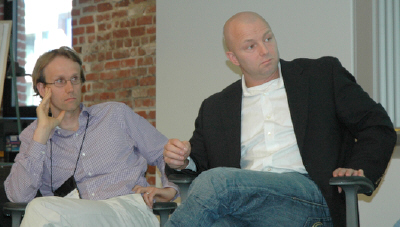Supernova: General Motors rising on social media

During a workshop at Supernova on the rise of social media, marketing whizes from General Motors, Proctor & Gamble and Yahoo discussed how they are harness the Web and content created by user to sell their products. According to an ancient Pew Research study from 2003, 44 percent of consumers are creating content, expressing themselves in some form online, from message boards and blogs to social networks and personal Web site. The reality today is that only a small percent of "big" advertising is going online. And, word of mouth is by far the best source for advice in buying products, according to many studies. "Conusmers are pushing companies to an interaction-based model from the traditional advertising model, said Stan Joosten, innovation manger at P&G.
In the context of the social media explosion, Michael Wiley, GM director of new media, didn't hold back. "The existing ad paradigm sucks, it's woefully inefficient. It takes huge dollars to create ads on TV that run for 30 or 60 seconds and give the consumer virtually no information," Wiley said. "The opportunity is to create relatively grassroots ads, six to eight minutes long that give an in depth brand experience and are released online."
He also said that customers could be incentivized to create ads themselves, with GM putting out a brief and asking individuals to create ads for a particular products. "Instead of GM producing ads online, we could use testimonials in existing online content as our advertising vehicles moving forward," he added. Customers creating videos, showing off a Chevy pick up truck doing some heavy work for example, could be harnessed, Wiley said. "Why not serve those up instead of a contrived advertisement."

Curt Hecht of GM Planworks and Michael Wiley, GM director of new media
Wiley also said a secret to GM's success is listening to conversations, including the negative comments. GM has blogs and comments on posts frequently bash and criticize the company's products. "You need to be open to criticism and willing to enage detractors," Wiley said. "Businesses like GM need to fundamentally change the way they operate. Customer engagement and every customer's opinion counts is just beginning. For years and years you could keep the squeaky wheel happy...now they can talk to a millions of people. The process to change the way business is done is slow process...and still mostly old way of doing business that has been around for 40 years."
Curt Hecht, executive vice president of GM Planworks (GM Planworks, a unit of Publicis Groupe's Starcom MediaVest Group, handles all buying and planning for GM's more than $3 billion account), added, "If we can't get people to dealers, we have to do it virtually and a 30-second spot is not the only way to do it."
"Enthusiasts and word of mouth is frickin huge for automotive. We haven't leveraged that relationship yet. It's a way to bring value to both parties...the voice could be larger than the Wall Street Journal [in influencing purchase decisions]. We just need to find the brand advocates," he continued.
The reality today is that only a small percent of "big" advertising is going online. It will be a slow process, both for GM and other large product companies and the broadcast networks. The old way isn't going away soon, but the smarter companies will embrace the Web and engage in the conversations. "We will continue to see the existing power structure subverted," Wiley said. "It's a period of upheaval, and I am confident it will just get better over the next few years," Wiley concluded.